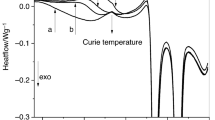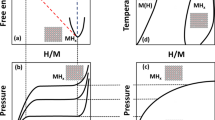Abstract
Measurements of the specific heat of the amalgam LiHg 3 are reported between approximately 7 and 300 K, and of CdHg 3 between approximately 10 and 300 K. The results are believed to be correct within uncertainty limits of ±3% at 300 K, rising to approximately ±12% at the lowest temperatures. Before seeking the influence of the addition of lithium and cadmium atoms to an assembly of mercury atoms, the quasiharmonic approximation has been applied to earlier experimental thermodynamic data to calculate the maximum frequencies v D (n) of the Debye distributions having the samenth moments as the crystalline mercury lattice for − 3 ≤n ≤ 6. This was followed by assessments of high-temperature limiting values of the Debye characteristic temperatures, which were subsequently used to express results at finite temperatures in reduced form for comparative purposes. From a survey of these and structural data it is concluded that: (i) vibrations parallel to the unique axis of each structure are probably more important than those at right angles in determining the cohesive forces; (ii) increasing the mean mass of the constituent atoms of the lattice results in an overall reduction of the vibrational frequencies; (iii) such an increase of mass is also accompanied by a reduction of the temperature at which explicitly temperature-dependent anharmonic effects assume significant proportions; and (iv) the temperature dependences of these effects resemble one another in the three lattices.
Similar content being viewed by others
References
R. M. Brade and B. Yates,J. Phys. C 4, 417 (1971).
A. J. Kirkham and B. Yates,Cryogenics 8, 381 (1968).
A. J. Kirkham and B. Yates,J. Phys. C 1, 1162 (1968).
R. M. Brade and B. Yates,J. Phys. C 4, 876 (1971).
C. S. Barrett,Acta Cryst. 10, 58 (1957).
R. H. Busey and W. F. Giauque,J. Am. Chem. Soc. 75, 806 (1953).
A. D. Misener,Proc. Roy. Soc. (London)A174, 262 (1940).
P. L. Smith and N. M. Wolcott,Phil. Mag. 1, 854 (1956).
V. J. Johnson,Properties of Materials at Low Temperatures (Phase 1), A Compendium (Pergamon Press, London, 1961), Part II, Chap. 4, p. 122.
W. T. Berg and J. A. Morrison,Proc. Roy. Soc. (itLondon)A242, 467 (1957).
A. G. Crocker and G. A. A. M. Singleton,Phys. Stat. Solidi 6, 635 (1971).
E. Grüneisen and O. Sckell,Ann. Physik 19, 387 (1934).
D. M. Hill,Phys. Rev. 48, 620 (1935).
O. Sckell,Ann. Physik 6, 932 (1930).
E. S. R. Gopal,Specific Heats at Low Temperatures (Heywood, London, 1966).
B. Yates,Thermal Expansion (Plenum Press, New York, 1972).
P. A. Giguère and M. Boisvert,Tables des Fonctions Thermodynamiques de Debye (Les Presses de l'Université Laval, Québec, 1962).
C. Domb and L. Salter,Phil. Mag. 43, 1083 (1952).
T. H. K. Barron, W. T. Berg, and J. A. Morrison,Proc. Roy. Soc. (London)A242, 478 (1957).
A. C. Bailey and B. Yates,Proc. Phys. Soc. 91, 390 (1967).
E. Grüneisen and H. Hoyer,Ann. Physik 22, 663 (1935).
A. D. Redmond and B. Yates,J. Phys. C 5, 1589 (1972).
N. Waterhouse and B. Yates,Cryogenics 8, 267 (1968).
G. J. Zukowsky,Z. Anorg. Chem. 71, 403 (1911).
G. Grube and W. Wolf,Z. Elektrochem. 41, 675 (1935).
E. Zintl and A. Schneider,Z. Elektrochem. 41, 771 (1935).
R. W. Munn,Advan. Phys. 18, 515 (1969).
A. C. Bailey and B. Yates,J. Appl. Phys. 41, 5088 (1970).
B. Yates, R. F. Cooper, and A. F. Pojur,J. Phys. C 5, 1046 (1972).
E. Maey,Z. Physik Chem. 29, 119 (1899).
B. Wood,Chem. News 6, 135 (1862).
R. F. Mehl,J. Am. Chem. Soc. 50, 381 (1928).
K. Schubert, U. Rösler, W. Mahler, E. Dörre, and W. Schütt,Z. Metallkunde 45, 643 (1954).
E. Maey,Z. Physik Chem. 50, 200 (1905).
K. Bornemann and G. Rauschenplat,Metallurgie 9, 473 (1912).
A. Larsen,Ann. Physik 1, 123 (1900).
A. C. Bailey and B. Yates,Phil. Mag. 16, 1241 (1967).
Author information
Authors and Affiliations
Rights and permissions
About this article
Cite this article
Bingham, J.L., Yates, B. Calorimetric and vibrational studies of LiHg3, CdHg3, and Hg. J Low Temp Phys 11, 117–130 (1973). https://doi.org/10.1007/BF00655040
Received:
Issue Date:
DOI: https://doi.org/10.1007/BF00655040




